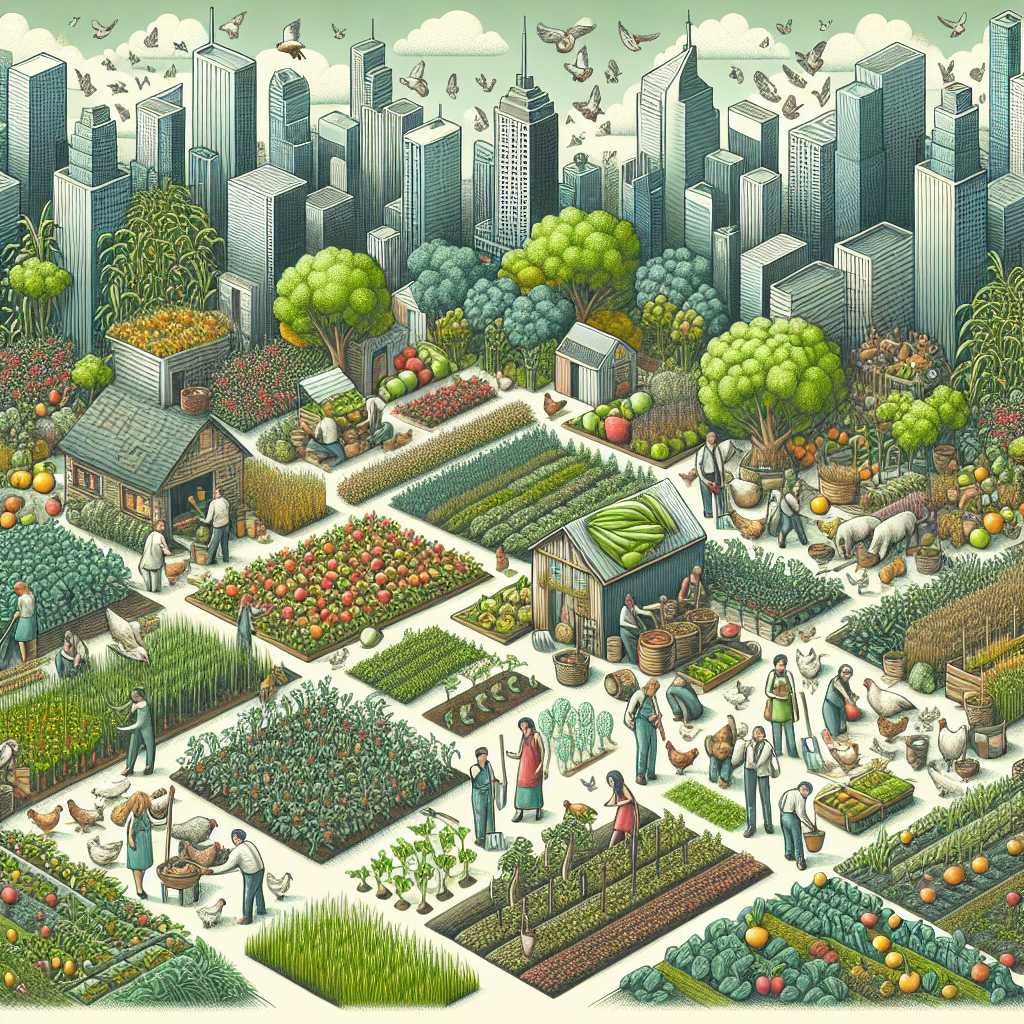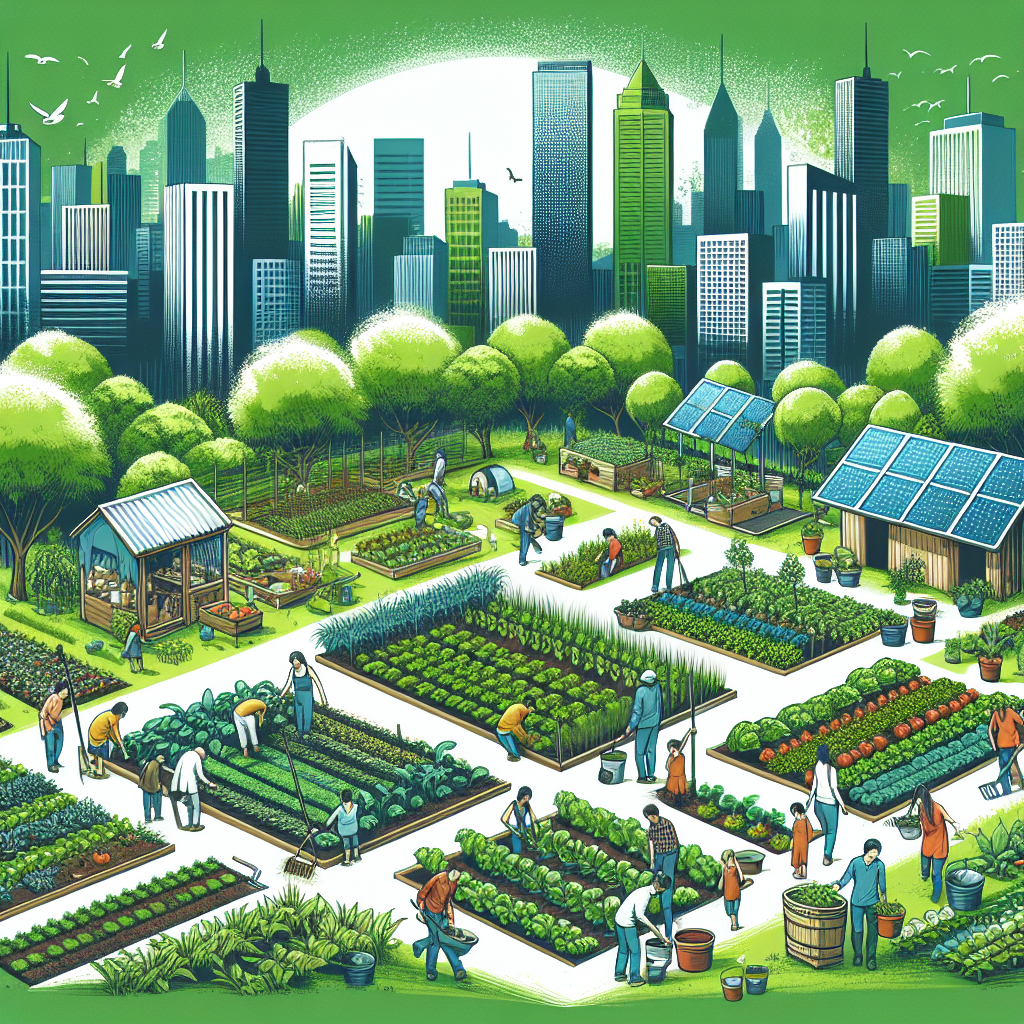
Imagine a world where fresh, nutritious produce is just a stone’s throw away from your doorstep. With urban farming, this vision becomes a reality. Urban farming plays a crucial role in the development of sustainable and local food systems, ensuring that communities have easy access to fresh, healthy food. By transforming vacant lots and rooftop spaces into thriving gardens, urban farming not only enhances the beauty of our cities but also fosters a sense of community and self-sufficiency. In this article, we will explore the importance of urban farming and how it can revolutionize our food systems for the better.

Benefits of Urban Farming
Reducing Food Miles
Urban farming plays a crucial role in reducing food miles, which refers to the distance food travels from the farm to the consumer. With traditional farming methods, food often needs to be transported long distances before reaching urban areas, resulting in high transportation costs, increased greenhouse gas emissions, and decreased freshness of produce. However, urban farming allows for the cultivation of crops closer to urban centers, significantly reducing the distance food needs to travel. By reducing food miles, urban farming helps to minimize the carbon footprint of the food system and ensures that fresher, more nutritious produce reaches consumers.
Increasing Access to Fresh Produce
One of the most significant benefits of urban farming is the increase in access to fresh produce for urban communities. In many cities, particularly low-income neighborhoods, access to fresh and affordable food is limited, leading to poor diets and increased health issues. By implementing urban farming initiatives, fresh fruits, vegetables, and herbs can be grown and made available to residents directly within their neighborhoods. This increase in access to fresh produce promotes healthier eating habits and improves overall community well-being.
Improving Food Security
Urban farming plays a vital role in improving food security by reducing reliance on external food sources. In the face of disruptions to global food supply chains, such as natural disasters or geopolitical events, urban communities with a robust urban farming infrastructure can ensure a more secure and reliable food supply. By producing a significant portion of their own food locally, cities can become more resilient and better equipped to meet the nutritional needs of their population, even in challenging times.
Promoting Sustainable Practices
Another critical benefit of urban farming is its promotion of sustainable agricultural practices. Traditional farming methods are often resource-intensive, requiring large amounts of water, fertilizers, and pesticides. In contrast, urban farming techniques, such as vertical farming, hydroponics, and aquaponics, minimize resource waste and pollution. These practices utilize water and nutrients more efficiently, reduce the need for chemical inputs, and create closed-loop systems that recycle resources. By adopting such sustainable practices, urban farming contributes to the conservation of natural resources and the preservation of the environment.
Creating Green Spaces in Cities
Urban farming provides an opportunity to transform underutilized spaces into vibrant green areas within cities. Vacant lots, rooftops, and even walls can be transformed into productive urban farms, bringing nature back into the urban landscape. These green spaces not only enhance the aesthetic appeal of cities but also provide environmental benefits. They help mitigate the urban heat island effect, improve air quality, and promote biodiversity by creating habitats for insects, birds, and other wildlife. Additionally, green spaces in the form of urban farms can serve as educational and recreational spaces, bringing communities together and connecting people with nature.
Challenges and Solutions in Urban Farming
Limited Space and Land Availability
One of the significant challenges in urban farming is the limited availability of space, particularly in densely populated cities. However, innovative techniques and technologies have emerged to address this challenge. Vertical farming, for example, utilizes vertical space by stacking plants in multiple layers. This maximizes the use of limited floor space while increasing overall farming capacity. Additionally, rooftop gardens provide an alternative farming location, utilizing underutilized space on buildings and contributing to the greening of urban areas.
Contamination and Soil Quality
Urban farming faces the challenge of contamination and soil quality in urban environments where soil may contain pollutants or heavy metals. This can impact the safety and quality of produce grown in urban farms. To address this, urban farmers can implement soil testing and remediation strategies to ensure safe and healthy soil conditions. Soil can be treated with organic amendments, such as compost, to promote better soil quality and fertility. Additionally, hydroponic and aquaponic systems eliminate the need for soil altogether, providing a soil-less method of cultivation.
Water Usage and Irrigation
Water scarcity is a critical issue in many urban areas, and efficient water usage is essential for sustainable urban farming. Techniques such as drip irrigation, which delivers water directly to the plants’ roots, minimize water waste by reducing evaporation and runoff. The use of technology, such as moisture sensors and automated irrigation systems, can further optimize water usage by ensuring that plants receive the right amount of water at the right time. Furthermore, urban farmers can explore the use of alternative water sources, such as rainwater harvesting and wastewater treatment, to reduce dependence on freshwater sources.
Lack of Knowledge and Expertise
Many individuals interested in urban farming may lack the necessary knowledge and expertise to start and maintain successful urban farms. To address this challenge, community organizations, educational institutions, and governmental agencies can provide training programs, workshops, and resources to empower individuals with the skills and knowledge needed for urban farming. Mentorship programs and networking opportunities can also facilitate knowledge sharing and support the growth of urban farming communities.
Obstacles to Policy and Regulation
Urban farming faces regulatory challenges, including zoning and land-use regulations that may restrict or exclude farming practices in urban areas. To overcome these obstacles, advocacy for urban farming policies and regulations is crucial. Urban farmers, organizations, and community members can engage with local governments to advocate for the implementation and revision of policies that support and promote urban farming. Partnerships between urban farmers and policymakers are essential to create an enabling environment that encourages and facilitates the growth of urban farming.

Urban Farming Techniques and Technologies
Vertical Farming
Vertical farming is a technique that involves cultivating crops in vertically stacked layers, such as in high-rise buildings or specially designed structures. This technique maximizes space utilization and allows for year-round farming by providing controlled environments for plants to grow. Vertical farming typically employs hydroponic or aeroponic systems, where plants are grown in nutrient-rich water or a mist environment without the use of soil. This technique reduces the need for land, water, and pesticides while increasing crop yields and minimizing the environmental impact of agriculture.
Rooftop Gardens
Rooftop gardens utilize otherwise unused rooftop spaces in urban areas for cultivating plants. These gardens can range from small rooftop plots to large-scale green roofs that cover entire buildings. Rooftop gardens provide numerous benefits, including reducing urban heat islands, improving air quality, and increasing access to fresh produce. Additionally, they can serve as community spaces, educational sites, and even be integrated with rainwater harvesting systems to further enhance sustainability.
Hydroponics and Aquaponics
Hydroponics and aquaponics are soil-less cultivation techniques that offer efficient resource utilization and higher crop yields compared to traditional farming methods. Hydroponics involves growing plants in nutrient-rich water solutions, while aquaponics combines fish farming (aquaculture) with hydroponics. In aquaponics systems, fish waste provides nutrients for the plants, while the plants filter the water for the fish. Both hydroponics and aquaponics allow for precise control of growing conditions, reduced water usage, and year-round cultivation, making them well-suited for urban farming.
Community Gardens
Community gardens are shared spaces where individuals or groups come together to grow food, flowers, and other plants. These gardens can be located on public or private land and provide opportunities for community members to actively participate in the cultivation process. Community gardens promote social interaction and community bonding while also providing access to fresh and healthy produce. They encourage knowledge sharing, support sustainable practices, and contribute to the overall well-being of urban neighborhoods.
Permaculture Design
Permaculture design is an approach to farming that follows principles of natural ecosystems, aiming to create regenerative and sustainable food production systems. It involves the integration of various elements, such as plants, animals, water, and soil, into a self-sustaining and mutually beneficial system. Permaculture designs often incorporate techniques such as companion planting, mulching, and water conservation to create resilient and productive urban farms. By mimicking natural ecosystems, permaculture promotes biodiversity, soil regeneration, and long-term sustainability.
Role of Urban Farming in Promoting Sustainability
Reducing Carbon Footprint
The carbon footprint of the food system is predominantly driven by long-distance transportation and energy-intensive agricultural practices. Urban farming significantly reduces the carbon footprint by minimizing food miles and reliance on fossil fuel-based transportation. With produce grown in urban farms, there is less need for long-haul transportation, resulting in reduced greenhouse gas emissions. Additionally, many urban farming techniques, such as vertical farming and hydroponics, utilize energy-efficient technologies and renewable energy sources, further reducing the carbon footprint of food production.
Conserving Resources
Urban farming promotes resource conservation by utilizing space, water, and nutrients more efficiently. With limited land availability in urban areas, urban farming techniques maximize the use of available space, enabling larger yields in smaller areas. Techniques such as hydroponics and aquaponics require significantly less water compared to traditional soil-based farming, reducing water consumption. Furthermore, urban farms can implement circular systems, such as composting and the use of organic waste as fertilizers, to minimize resource waste and support a closed-loop approach.
Mitigating Climate Change
The production and consumption of food account for a significant portion of greenhouse gas emissions and contribute to climate change. Urban farming addresses this issue by reducing emissions through localized production and short supply chains. The use of sustainable farming practices, such as organic cultivation methods and efficient resource use, further reduces the environmental impact. Additionally, urban farms can act as carbon sinks by sequestering carbon in soil and vegetation, contributing to climate change mitigation efforts.
Preserving Biodiversity
Intensive agricultural practices often lead to habitat destruction, loss of biodiversity, and the use of harmful pesticides. Urban farming, particularly techniques like permaculture and community gardens, promotes the preservation of biodiversity in urban areas. By providing habitats for various plant and animal species, urban farms create opportunities for biodiversity to thrive within densely populated cities. The inclusion of native plant species and the avoidance of chemical inputs also contribute to the preservation of biodiversity and the restoration of ecosystems.
Encouraging Waste Reduction
Urban farming can play a vital role in reducing food waste by utilizing surplus or imperfect produce that would otherwise be discarded. Through initiatives such as gleaning programs or collaborations with food recovery organizations, urban farmers can redirect excess produce to those in need, minimizing food waste. Additionally, urban farms can incorporate composting systems to convert organic waste into nutrient-rich compost, closing the waste loop and contributing to a circular economy.

Building Local Food Systems
Supporting Local Economies
Urban farming strengthens local economies by providing employment opportunities and supporting local businesses. Urban farms often require a workforce, ranging from farmers and gardeners to distributors and sellers, creating jobs within the community. Moreover, by supplying fresh produce directly to local markets, urban farmers contribute to the vitality of local businesses, such as restaurants, grocery stores, and farmers’ markets. This localized food economy improves economic resilience and fosters a sense of pride and self-sufficiency within the community.
Strengthening Community Connections
Urban farming has the power to bring communities together and foster a sense of belonging and shared responsibility. By engaging in communal gardening activities, individuals from diverse backgrounds can connect and form social bonds. Community gardens, in particular, serve as gathering spaces where people can exchange knowledge, share resources, and collaborate towards common goals. These shared experiences and relationships strengthen social fabric and promote a sense of community ownership over local food production.
Enhancing Food Culture and Diversity
Urban farming encourages a more diverse and sustainable food culture by promoting the cultivation of a wide range of crops and plant varieties. By growing culturally significant crops and heirloom varieties, urban farms help preserve traditional culinary practices and promote culinary diversity. Additionally, urban farms can partner with local chefs, restaurants, and food entrepreneurs to showcase unique flavors and dishes using locally grown produce. This enhances the local food identity and celebrates the cultural heritage of the community.
Reducing Reliance on Global Supply Chains
Urban farming reduces dependence on global supply chains, making local communities more resilient to disruptions in food distribution caused by natural disasters, transportation issues, or crises. By producing food locally, cities can maintain a more stable and reliable food supply, mitigating the risks associated with global trade and ensuring food security for their residents. This self-sufficiency in food production lessens vulnerability to external factors and strengthens the overall resilience of the local food system.
Improving Food Resilience
Urban farming contributes to food resilience by diversifying and decentralizing food production. As urban farms are dispersed throughout cities, they create a network of interconnected food producers. In the event of a supply disruption, such as a natural disaster or transportation breakdown, this decentralized network allows for localized production to continue, ensuring a steady supply of fresh produce. By increasing the overall resilience of the food system, urban farming helps communities bounce back more quickly from challenges and adapt to changing circumstances.
Urban Farming Initiatives and Success Stories
Urban Agriculture in Detroit
Detroit has been at the forefront of the urban farming movement, transforming vacant lots into productive urban farms. Through initiatives such as Hantz Farms and the Detroit Black Community Food Security Network, the city has reclaimed abandoned land and revitalized neighborhoods through urban agriculture. These initiatives not only provide fresh produce to residents but also create job opportunities and a sense of community pride.
EcoFarm in San Francisco
EcoFarm, a community farm located in San Francisco, is an excellent example of urban farming’s potential to promote sustainability and community engagement. EcoFarm utilizes rooftop gardens, vertical farming, and permaculture techniques to grow a wide range of organic produce. The farm not only provides fresh vegetables, fruits, and herbs to the local community but also educates and empowers individuals to grow their own food through workshops and programs.
The Rooftop Farm Project in New York City
The Rooftop Farm Project in New York City showcases the possibilities of transforming underutilized urban spaces into productive farmland. With over 1.5 acres of rooftop farms across multiple locations, this project demonstrates the potential for urban farming to thrive even in densely populated cities. The Rooftop Farm Project not only produces and sells fresh produce but also hosts educational programs, community events, and partnerships with local organizations to promote sustainable agriculture and food access.
Vertical Farming Startups
Various innovative vertical farming startups have emerged worldwide, leveraging technology and sustainable practices to transform urban agriculture. Companies like AeroFarms and Plenty utilize vertical farming technologies to produce large quantities of leafy greens and other vegetables in controlled indoor environments. These startups demonstrate the potential of urban farming to scale up production, reduce resource consumption, and bring fresh produce closer to urban populations.

The Role of Education and Awareness
Teaching Sustainable Farming Practices
Education and awareness play a crucial role in promoting sustainable urban farming practices. Educational institutions, community organizations, and urban farming networks can provide training programs and workshops to teach individuals about sustainable farming techniques, such as organic cultivation methods and efficient resource management. By equipping aspiring urban farmers with the necessary knowledge and skills, education fosters the adoption of sustainable practices and strengthens urban farming communities.
Promoting Food Literacy
Food literacy refers to the knowledge and understanding of where food comes from, how it is produced, and how it impacts personal and environmental health. Urban farming initiatives can actively promote food literacy among community members by organizing workshops, cooking classes, and educational events. By engaging individuals in experiential learning and involving them in the cultivation process, urban farming fosters a deeper connection with food and promotes informed food choices.
Engaging Communities in Urban Agriculture
Urban farming is most successful when it involves the active participation of the community. Community engagement initiatives, such as volunteer programs, community workdays, and co-gardening opportunities, encourage community members to take an active role in urban farming. By involving the community in the planning, cultivation, and harvesting processes, urban farms become vibrant, inclusive spaces that foster a sense of ownership and pride.
Empowering Individuals to Grow Their Own Food
Urban farming initiatives can empower individuals to take control of their food security by providing resources and support for growing their own food. Community gardens, allotments, and rooftop gardens serve as spaces where individuals can learn and practice gardening skills while producing their own fresh produce. Growing one’s food not only promotes self-sufficiency and resilience but also fosters a deeper appreciation for the natural world and the processes involved in food production.
Advocating for Urban Farming Policies
Education and awareness are essential for advocating and shaping urban farming policies that promote sustainable and inclusive urban agriculture. By raising awareness about the benefits of urban farming, engaging with policymakers, and mobilizing community support, urban farming initiatives can drive policy changes. This includes advocating for land-use regulations that support urban agriculture, incentivizing the use of sustainable farming practices, and establishing supportive funding mechanisms to encourage the development of urban farming projects.
Collaboration and Partnerships in Urban Farming
Public-Private Partnerships
Collaboration between public and private entities is key to the success of urban farming initiatives. Public-private partnerships can provide the necessary resources, expertise, and funding to support the development and implementation of urban farming projects. Governments can offer land or financial incentives, while private entities can bring in technical knowledge, investment, and market access. These collaborations ensure a mutually beneficial relationship, fostering sustainable and scalable urban farming models.
Community Organizations and NGOs
Community organizations and non-governmental organizations (NGOs) play a vital role in supporting and empowering urban farming initiatives. These organizations provide resources, educational programs, and networking opportunities for urban farmers. They also act as catalysts for community engagement and advocacy, promoting the benefits of urban farming and facilitating knowledge sharing among stakeholders.
Support from Local Governments
Active support from local governments is crucial for the growth and success of urban farming. Local governments can play a role in facilitating access to land, creating appropriate zoning regulations, and streamlining the permitting process for urban farming projects. They can also provide financial incentives, technical assistance, and resources to support urban farmers and develop sustainable farming infrastructure.
Corporate Sponsorship and Philanthropy
Corporate sponsorship and philanthropic support can significantly contribute to the development of urban farming initiatives. By partnering with urban farms, businesses can promote their commitment to sustainability, support local food systems, and improve their corporate social responsibility profiles. Additionally, philanthropic organizations can provide grants and funding opportunities to support research, education, and infrastructure development in urban farming.
Knowledge Sharing and Networking
Knowledge sharing and networking among urban farming stakeholders are crucial for the growth and success of the movement. Urban farming conferences, workshops, and online platforms facilitate the exchange of ideas, experiences, and best practices. By creating networks and fostering collaboration among farmers, researchers, policymakers, and community members, urban farming can continue to innovate and evolve, addressing challenges and sharing success stories.

Overcoming Barriers to Urban Farming
Access to Land and Real Estate
Access to appropriate land is often a significant barrier for urban farming. High land prices, limited availability, and competition from other land uses pose challenges for urban farmers. To overcome this barrier, partnerships between landowners, local governments, and urban farming initiatives can be established. Landowners can lease or donate land for farming purposes, while governments can facilitate the creation of land banks, zoning changes, and incentive programs to promote urban farming.
Financial Support and Investment
Lack of financial resources and investment can hinder the development and expansion of urban farming projects. To overcome this, urban farmers can explore alternative funding sources, such as crowdfunding, grants, and microloans. Local governments and financial institutions can establish loan programs and provide financial support tailored to the needs of urban farming initiatives. Support from philanthropic organizations and corporate sponsors can also provide critical funding for research, infrastructure, and capacity-building efforts.
Addressing Zoning and Planning Regulations
Outdated or restrictive zoning and planning regulations can impede the growth of urban farming. To overcome this challenge, urban farmers and organizations can work with local governments to revise regulations and develop inclusive zoning codes that specifically address urban agriculture. This can include creating special zones for urban farming, allowing mixed land uses, and streamlining the permitting process for urban farming projects.
Promoting Social Equity and Inclusion
Urban farming initiatives must address social equity and inclusion to ensure that all communities have access to the benefits of urban farming. This includes actively engaging marginalized communities and providing resources, training, and support to ensure equal access to urban farming opportunities. Community organizations and grassroots initiatives can play a crucial role in advocating for social equity in urban farming and providing platforms for underrepresented voices to be heard.
Incorporating Urban Farming in Urban Planning
To fully integrate urban farming into cities, it is essential to incorporate it into urban planning processes. This includes including urban farming in city development plans, zoning maps, and building codes. By prioritizing urban farming in urban planning, cities can allocate appropriate spaces for agricultural activities, encourage the inclusion of green infrastructure, and foster a supportive environment for urban farming initiatives.
Conclusion: The Future of Urban Farming
Scaling Up Urban Farming Efforts
The future of urban farming lies in scaling up efforts to meet the growing demand for sustainable, locally produced food. By leveraging innovative techniques, such as vertical farming and hydroponics, and incorporating smart technologies, urban farming can increase production capacity while minimizing resource consumption. Scaling up also involves fostering public-private collaborations, expanding education and awareness programs, and developing supportive policies and regulations that facilitate the growth of urban farming.
Integration with Smart City Solutions
The integration of urban farming with smart city solutions has the potential to revolutionize food production in urban areas. By utilizing data-driven technologies, such as Internet of Things (IoT) sensors and automation systems, urban farmers can optimize resource use, monitor plant health, and improve overall farm efficiency. Smart city solutions can also enable the integration of urban farming with other aspects of urban life, such as energy management, waste management, and transportation, creating a more sustainable and interconnected urban ecosystem.
Advancing Sustainable and Regenerative Practices
As urban farming continues to evolve, a greater emphasis will be placed on advancing sustainable and regenerative practices. This includes further reducing resource consumption, optimizing nutrient cycling, and minimizing waste generation. The adoption of regenerative agriculture practices, such as agroforestry and soil regeneration techniques, can help restore soil health, enhance biodiversity, and promote long-term sustainability in urban farming.
Empowering Communities through Local Food Systems
Urban farming serves as a catalyst for empowering communities and fostering resilience. The future of urban farming lies in continually empowering individuals and communities to take control of their food systems, from production to distribution and consumption. By building inclusive and accessible models of food production and distribution, urban farming can address food insecurity, foster self-sufficiency, and contribute to the overall well-being of communities.
Continued Innovation and Collaboration
The success and growth of urban farming depend on continued innovation and collaboration across various stakeholders. As urban farming evolves, there will be a need for ongoing research and development of new techniques, technologies, and best practices. Collaboration among urban farmers, researchers, policymakers, and community members will be essential for knowledge sharing, problem-solving, and driving the urban farming movement forward. By embracing innovation and collaboration, urban farming can continue to make a significant impact in building sustainable and local food systems.







